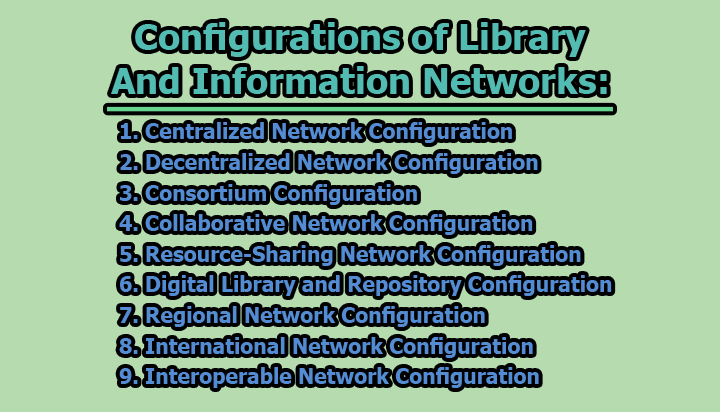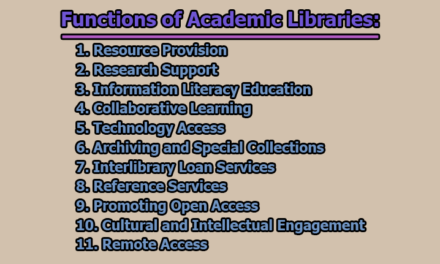Configurations of Library and Information Networks:
Library and information networks can take various configurations, depending on their scope, structure, and purpose. These configurations are designed to facilitate the exchange of information, resources, and services among libraries, institutions, and users. Here are some common configurations of library and information networks:
- Centralized Network Configuration:
- In this configuration, a central hub or governing body coordinates and manages the network’s operations.
- Member libraries or institutions connected to the central entity, provide services such as cataloging, resource sharing, and technical infrastructure.
- Centralized networks are often seen in national library networks, where a national library acts as a central authority.
- Decentralized Network Configuration:
- In a decentralized network, participating libraries or institutions maintain a significant degree of autonomy.
- Each library or institution manages its own resources and services but collaborates with others in the network for specific purposes, such as resource sharing or metadata sharing.
- Academic library consortia and regional library networks sometimes adopt this configuration.
- Consortium Configuration:
- Library consortia consist of multiple libraries or institutions that join together voluntarily to achieve common goals.
- Member libraries retain a level of independence but work collectively to leverage their combined resources and purchasing power.
- Consortia may adopt various governance models, including formal agreements and shared services.
- Collaborative Network Configuration:
- Collaborative networks emphasize collaboration and mutual support among participating libraries or institutions.
- Libraries work together to share resources, expertise, and services, often in an informal and cooperative manner.
- These networks foster a culture of collaboration and knowledge exchange.
- Resource-Sharing Network Configuration:
- Resource-sharing networks are designed primarily for interlibrary loan and resource-sharing purposes.
- They facilitate the borrowing and lending of materials among member libraries, enabling access to resources not available locally.
- These networks often adopt standardized protocols and systems to streamline resource sharing.
- Digital Library and Repository Configuration:
- Digital library and repository networks connect institutions with digital collections and repositories.
- They facilitate the sharing, preservation, and dissemination of digital resources, including digitized books, manuscripts, and research materials.
- These networks may adopt common metadata standards for interoperability.
- Regional Network Configuration:
- Regional library networks serve a specific geographic region, such as a state or province.
- They collaborate to provide shared library services, resource sharing, and cooperative initiatives tailored to the needs of the region.
- These networks may include public, academic, and special libraries within the region.
- International Network Configuration:
- International library and information networks operate on a global scale, connecting libraries, institutions, and organizations across different countries.
- They facilitate international cooperation, resource sharing, and the exchange of cultural materials and knowledge.
- International networks often focus on global challenges and initiatives, such as digitization and preservation.
- Interoperable Network Configuration:
- Interoperable networks prioritize compatibility and interoperability among member libraries’ systems and technologies.
- They adopt common data formats, protocols, and standards to ensure seamless data exchange and collaboration.
- Interoperability is crucial for effective resource sharing and access to shared services.
These configurations reflect the diverse ways in which library and information networks are structured to meet the specific needs of their member libraries, institutions, and users. The choice of configuration often depends on factors such as the network’s goals, geographic scope, and governance structure.

Assistant Teacher at Zinzira Pir Mohammad Pilot School and College










